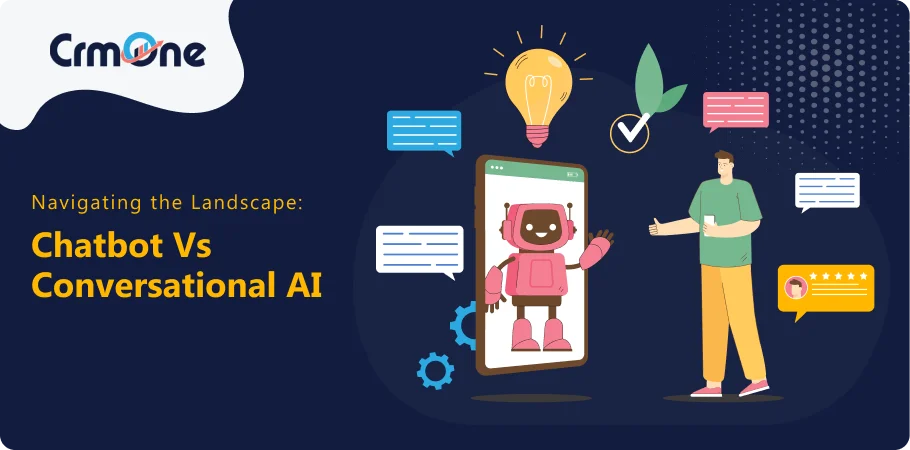In the realm of digital interactions, the terms ‘chatbot’ and ‘conversational AI’ often emerge, sometimes used interchangeably, sometimes with distinct connotations. These technologies revolutionize the way we engage with machines, blurring the lines between human and artificial intelligence. In this comprehensive guide on Chatbot vs Conversational AI, we delve deep into the nuances of chatbots and conversational AI, exploring their functionalities, applications, and the pivotal differences that set them apart.
Moreover, we investigate how intelligent chatbots aim to replicate human interactions, bringing us closer to seamless human-machine communication.
Understanding Conversational AI
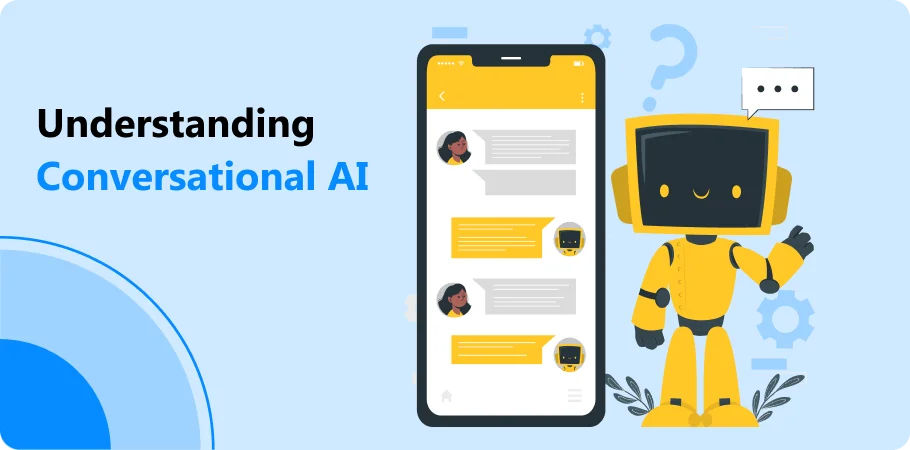
Conversational AI, also referred to as conversational artificial intelligence, epitomizes a sophisticated amalgamation of natural language processing (NLP), machine learning (ML), and AI technologies. Unlike conventional rule-based chatbots, conversational AI systems demonstrate the capacity to grasp human conversation nuances, interpret user intent, and participate in contextually relevant dialogues.
These systems serve as the backbone for numerous applications, ranging from virtual assistants to customer service solutions, thereby revolutionizing user experiences across various industries.
Use cases for chatbot vs conversational AI in customer service?

In the realm of customer service, both chatbots and conversational AI play pivotal roles, albeit with distinct functionalities and applications. Let’s explore some use cases where each excels:
1. Basic Chatbots for Routine Inquiries:
Basic chatbots, often rule-based, are adept at handling routine inquiries and frequently asked questions. These chatbots operate within predefined parameters and can swiftly provide information on topics like store hours, product availability, or shipping details. For instance, a basic chatbot can assist customers in tracking their orders or locating nearby stores. Additionally, they serve as valuable resources for voice assistants, facilitating seamless interactions and enhancing user experiences.
2. Advanced Conversational AI for Complex Queries:
Conversational AI, conversely, excels in managing complex queries and nuanced interactions. Unlike basic chatbots, AI bots possess the capability to comprehend natural language nuances, decipher user intent, and adjust to diverse contexts. This renders them well-suited for efficiently resolving intricate consumer requests. For instance, an AI bot deployed by an airline company can assist travelers in rebooking flights, managing cancellations, or addressing flight delays with ease and accuracy.
3. Personalized Recommendations and Assistance:
Conversational AI chatbots excel in providing personalized recommendations and assistance tailored to individual preferences. By leveraging machine learning algorithms, these chatbots can analyze user behavior, past interactions, and purchase history to offer relevant product recommendations or suggest personalized solutions.
For instance, a conversational AI bot deployed by an e-commerce platform can guide users through the product selection process, offer styling tips, and recommend complementary items based on their preferences and browsing history.
4. Multi-channel Support and Seamless Integration:
Conversational AI platforms facilitate seamless integration across various channels, encompassing websites, mobile apps, social media platforms, and messaging applications. This integration empowers businesses to provide uniform and tailored experiences. customer support experiences across multiple touchpoints. Whether customers engage via chat, email, or voice, the conversational AI chatbot ensures a cohesive and unified interaction.
For instance, integrating a conversational AI chatbot within a company’s website allows for smooth transitions from text-based chats to voice-based interactions, ensuring uninterrupted support for customers across all channels.
These advanced conversational AI chatbots are tailored to efficiently address and resolve customer requests. Leveraging sophisticated algorithms and natural language processing capabilities, they streamline the support process, enhancing efficiency and customer satisfaction. With conversational AI chatbots at the forefront, businesses can effectively handle a wide range of inquiries and issues, providing timely and effective solutions to meet customer needs.
5. Proactive Engagement and Customer Retention:
Conversational AI chatbots can also proactively engage customers through personalized messages, notifications, and alerts. By leveraging predictive analytics and customer data, these chatbots can anticipate user needs, offer timely assistance, and foster customer engagement and loyalty. For instance, a AI assistant chatbot deployed by a subscription-based service can send personalized reminders, recommendations, and promotional offers based on user preferences and usage patterns, enhancing customer retention and satisfaction.
6. Data-driven Insights and Continuous Improvement:
Conversational AI platforms provide valuable insights into customer preferences, behaviors, and pain points through advanced analytics and reporting capabilities. By analyzing conversational data, businesses can gain actionable insights, identify trends, and make informed decisions to enhance the overall customer experience.
For example, a conversational AI platform equipped with sentiment analysis tools can gauge customer satisfaction levels, identify common issues, and prioritize areas for improvement, driving continuous enhancement and innovation in customer service delivery.
In summary, while simple chatbots excel in handling routine inquiries and providing standardized responses, conversational AI shines in addressing complicated queries, offering personalized assistance, and fostering meaningful interactions with customers.
By leveraging the strengths of both technologies, businesses can deliver exceptional customer service experiences, resolve consumer requests efficiently, and drive consumer satisfaction and loyalty.
Book a CrmOne Demo
Experience the CrmOne simplicity and power. Our experts will show you the best ways to use it and answer your questions in real time. See how CRMOne fits your needs.
How AI conversational bots can empower your customers
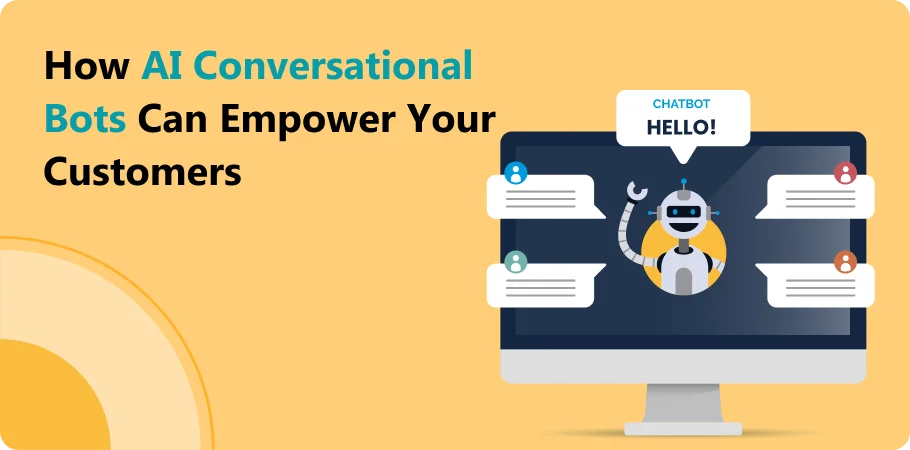
In the digital age, customer service stands at the forefront of business success. The ability to address customer queries promptly and efficiently can make all the difference in cultivating customer loyalty and driving business growth. With the advent of artificial intelligence (AI) bots, businesses now have a powerful tool at their disposal to enhance customer support experiences. In this article, we’ll explore how AI bots leverage natural language understanding to engage customers in complicated and nuanced conversations, ultimately empowering businesses to deliver exceptional support.
1. Understanding Natural Language: The Key to Effective Communication
At the heart of AI conversational bots lies natural language understanding (NLU), a critical component that enables machines to comprehend and interpret natural language. Unlike traditional bots that operate on predefined rules, AI conversational bots equipped with NLU capabilities can decipher the intricacies of human speech, allowing for more fluid and contextually relevant interactions.
2. Empowering Customers with Seamless Communication
One of the primary advantages of AI bots is their ability to engage customers in complicated and nuanced conversations. Whether addressing product inquiries, handling support requests, or assisting with troubleshooting, AI bots can navigate through various conversation flows with ease, providing customers with the information they need in a manner that mimics human interactions.
3. Enhancing Support Experiences with AI-Powered Solutions
By leveraging AI bots, businesses can resolve consumer requests efficiently, streamlining the support process and reducing customer wait times. These bots can handle a wide range of queries, from basic FAQs to more intricate issues, empowering customers to find solutions to their problems quickly and conveniently.
4. Navigating Complex and Nuanced Conversations
In today’s fast-paced world, customers expect support experiences that cater to their individual needs and preferences. AI bots excel in navigating complicated and nuanced conversations, adapting their responses based on the context of the interaction and the specific needs of the customer.
This level of personalization ensures that customers receive the assistance they require, leading to higher levels of satisfaction and loyalty.
The integration of such personalized services ensures that patrons receive the precise assistance they necessitate, ultimately leading to heightened levels of satisfaction and allegiance. This tailored approach not only enhances the customer experience but also fosters a deeper understanding of individual needs and preferences.
Through conversational interfaces, clients engage in interactions that are finely attuned to their requirements, facilitating a more efficient resolution of their inquiries and concerns.
5.Unlocking the Power of AI Conversational Bots
The potential applications of AI bots in customer service are vast and diverse. From providing real-time support on websites and mobile apps to offering personalized assistance through voice-enabled interfaces, AI bots can revolutionize the way businesses engage with their customers.
By harnessing the power of NLU, these bots can understand the intent behind customer queries, anticipate their needs, and deliver tailored responses that enhance the overall support experience.
Differentiating Chatbots and Conversational AI chatbots
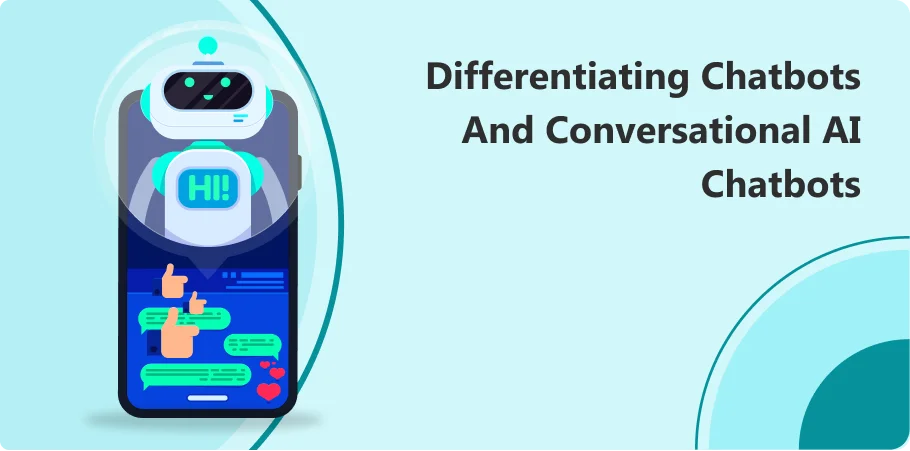
The distinction between chatbots and conversational AI lies in their underlying technologies and capabilities. Chatbots, primarily rule-based, operate within predefined parameters and lack the sophistication to understand human language intricacies.
Conversely, conversational AI leverages advanced NLP algorithms and ML models to interpret user intention, adapt to varying contexts, and deliver personalized responses.
Evolution from Rule-based Chatbots to Conversational AI
Rule-based chatbots, while functional for basic tasks, exhibit limitations in handling nuanced conversations and addressing complicated queries. Conversational AI, on the other hand, relies on vast datasets and iterative learning processes to continuously enhance its understanding of natural language and refine its conversational abilities.
This evolution marks a significant leap in the realm of AI-powered interactions, enabling seamless communication between humans and machines.
Applications of Conversational AI
The applications of conversational AI span across diverse domains, revolutionizing customer service experiences, streamlining business operations, and augmenting productivity. From virtual assistants guiding users through tasks to AI-driven chatbots providing quick customer support, conversational AI systems redefine the possibilities of human-computer interactions.
Enhancing Customer Service with Conversational AI
In the realm of customer service, conversational AI emerges as a game-changer, empowering organizations to deliver prompt, personalized support round-the-clock. Unlike traditional customer service teams, conversational AI agents operate tirelessly, leveraging their understanding of human language to address customer requests efficiently. Whether resolving simple inquiries or tackling more complex issues, conversational AI systems elevate the overall customer service experience.
The Role of Natural Language Processing
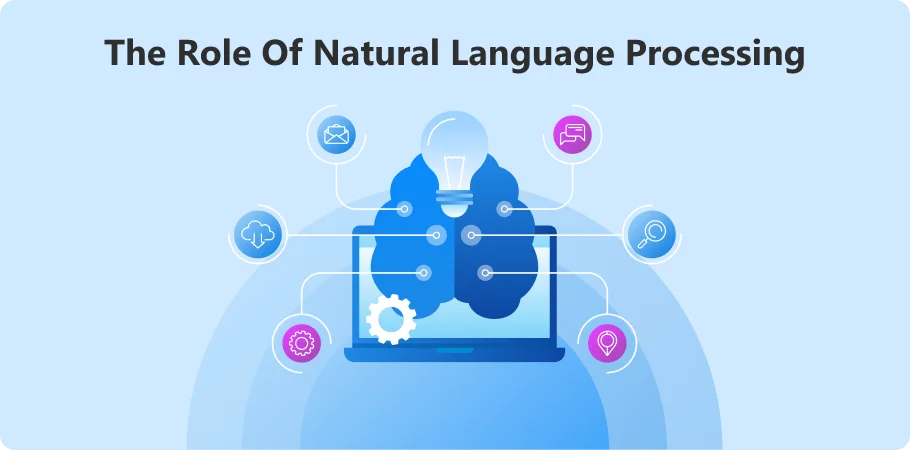
At the heart of conversational AI lies natural language processing, a branch of AI dedicated to enabling computers to understand, interpret, and generate human language. By harnessing the power of NLP algorithms, conversational systems decipher user input, extract relevant information, and generate contextually appropriate responses. This intricate process underpins the seamless flow of communication between users and AI-powered interfaces.
Chatbots vs Conversational AI: Unveiling the Differences
While both chatbots and conversational AI serve as conduits for human-computer interactions, their fundamental disparities shape their respective functionalities and applications. Rule-based chatbots operate within rigid frameworks, executing predefined tasks without the ability to adapt to evolving contexts.
In contrast, conversational systems exhibit a higher degree of flexibility, leveraging advanced AI technologies to understand user intention, mimic human interactions, and navigate complex conversations.
Harnessing the Power of Machine Learning
Machine learning algorithms are crucial in bolstering the functionality of conversational AI systems. They refine their comprehension of human language patterns through consistent exposure to training data and feedback loops, facilitating the evolution of conversational AI agents. Embracing a data-driven methodology, organizations can harness the power of machine learning to unleash fresh opportunities within conversational AI applications.
These algorithms continuously refine their understanding of linguistic nuances, thereby enhancing the effectiveness of conversational interactions. Through iterative learning processes, conversational AI systems adapt and improve their responses over time.
The integration of machine learning empowers conversational AI agents to better comprehend and respond to user queries and commands. Organizations leveraging machine learning in conversational AI applications stand to benefit from improved efficiency and efficacy in consumer interactions. These systems, driven by machine learning algorithms, possess the capability to evolve and adapt in dynamic environments.
Empowering Businesses with Conversational AI
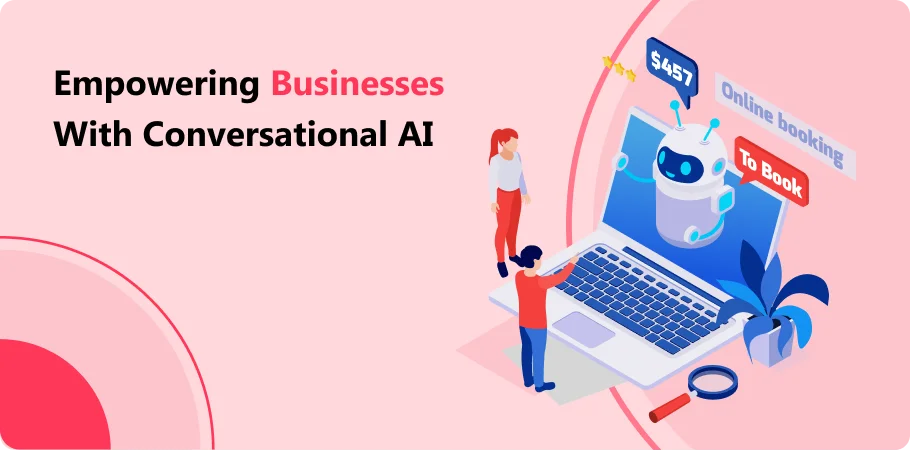
For businesses seeking to elevate customer interactions and streamline operations, conversational AI presents a transformative solution. By deploying AI-powered chatbots and virtual assistants, organizations can deliver quick, personalized support, enhance consumer satisfaction, and drive operational efficiency. Whether facilitating sales transactions or providing real-time assistance, conversational AI technology empowers businesses to stay ahead in today’s competitive landscape.
In today’s highly competitive business landscape, leveraging conversational AI technology not only allows companies to facilitate sales transactions smoothly but also provides timely assistance to customers, thus enabling them to maintain a competitive edge. Through the utilization of AI-based chatbots, businesses can streamline their operations and enhance customer service efficiency.
These computer programs, in the form of AI-based chatbots, efficiently handle diverse tasks such as processing sales inquiries and delivering immediate support, ensuring companies remain agile and responsive to the evolving demands of consumers.
Navigating Complex Customer Interactions
In the realm of customer service, conversational AI excels in navigating complex customer interconnections, ranging from product inquiries to troubleshooting issues. Unlike traditional chatbots, which operate within predefined parameters, conversational systems possess the ability to understand natural language nuances, identify user intent, and provide tailored solutions.
Challenges and Opportunities in Conversational AI
Despite its transformative potential, conversational AI poses certain challenges, ranging from data privacy concerns to ethical considerations. As conversational systems become increasingly integrated into daily interactions, addressing these challenges becomes paramount to ensure responsible deployment and usage. By embracing ethical AI practices and prioritizing user privacy, organizations can harness the full potential of conversational AI while mitigating associated risks.
Future Trends in Conversational AI relies
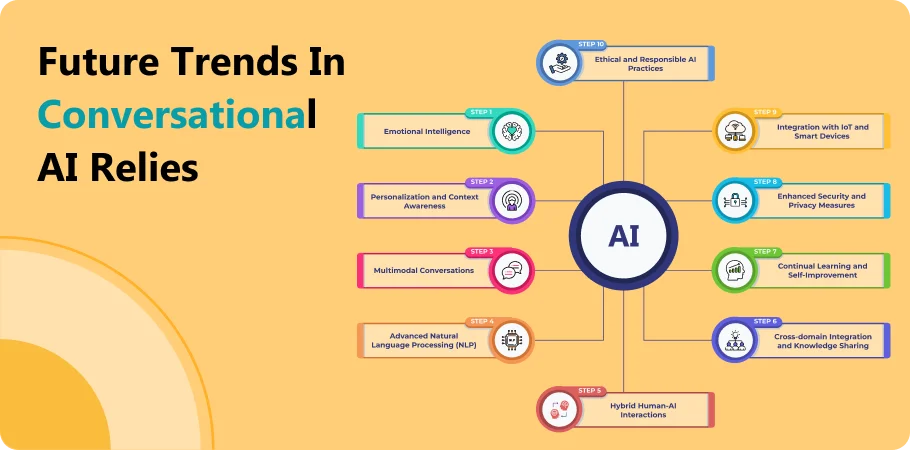
1. Advanced Natural Language Processing (NLP):
Future trends in conversational AI are likely to focus on refining NLP capabilities.
2. Multimodal Conversations:
Conversational AI is expected to evolve towards supporting multimodal interactions, integrating text, voice, images, and even gestures.
3. Personalization and Context Awareness:
The future of conversational AI lies in providing personalized experiences tailored to individual users.
4. Emotional Intelligence:
Emerging trends suggest a focus on imbuing conversational AI with emotional intelligence. Future systems will be capable of recognizing and responding to user emotions, adapting their tone and demeanor accordingly.
5. Integration with IoT and Smart Devices:
As the Internet of Things (IoT) continues to proliferate, conversational AI will increasingly integrate with smart devices and connected environments.
6. Enhanced Security and Privacy Measures:
With growing concerns about data privacy and security, future trends in conversational AI will prioritize robust security measures.
7. Continual Learning and Self-Improvement:
Future conversational AI systems will adopt continual learning capabilities, allowing them to adapt and improve over time.
8. Cross-domain Integration and Knowledge Sharing:
To provide more comprehensive assistance, future conversational AI systems will integrate knowledge from diverse domains and sources.
9. Ethical and Responsible AI Practices:
With the increasing influence of conversational AI in society, future trends will prioritize ethical and responsible AI practices.
10. Hybrid Human-AI Interactions:
Lastly, future conversational AI trends may involve fostering hybrid human-AI interactions, where AI systems collaborate with human agents to deliver superior services.
Conclusion
In conclusion, the distinction between chatbots and conversational AI lies not only in their underlying technologies but also in their capabilities to understand human language nuances and adapt to dynamic contexts. While rule-based chatbots served as precursors to conversational AI, the latter represents a quantum leap in AI-powered interactions, enabling seamless communication between humans and machines.
As organizations harness the power of conversational AI to enhance customer experiences, streamline operations, and drive innovation, the era of conversational AI unfolds with boundless opportunities for transformative change.
Get started for Free
Start for free today. Boost your sales by clicking the Get Started button. With CRMOne, you can manage leads, sales, and customer service all in one place.
